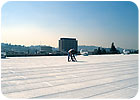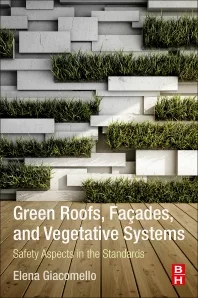The Green Movement Sweeps Eastward
What began on the West Coast with the passing of California’s Revised Title 24 Code in October 2005 has quickly spread throughout the entire country. Today, most major cities across the United States have adopted some form of energy efficiency standards for new construction and existing buildings.

What began on the West Coast with the passing of California’s Revised Title 24 Code in October 2005 has quickly spread throughout the entire country. Today, most major cities across the United States have adopted some form of energy efficiency standards for new construction and existing buildings.
In May 2006, Seattle approved a plan to offer incentives and encourage site-appropriate packages of greening possibilities including green roofs, interior green walls, exterior vertical landscaping, and rain gardens, which can help with building insulation, shading, air filtration, and stormwater runoff management. Seattle was also the first municipality in the nation to adopt the U.S. Green Building Council’s Leadership in Energy and Environmental Design (LEED) Silver rating for its own major construction projects.
New York City Local Law 86 (also known as “The LEED Law”) became effective in January 2007 and requires that many of New York City’s new municipal buildings, as well as additions and renovations to existing municipal buildings, achieve exacting standards of sustainability that satisfy various LEED criteria.
Washington, D.C.’s Green Building Act of 2006 went into effect in March 2007, and requires compliance with the LEED rating system for both private and public projects within the nation’s capital. Washington, D.C., is the first major U.S. city to require LEED compliance for private projects. These new green building standards will be mandatory in the District by 2009 for privately owned, non-residential construction projects with 50,000 square feet or more; however, public projects may have to comply with these new standards as early as this year.
Pennsylvania is currently second to California for the number of LEED-certified buildings at 83, and currently has four state funds, including the $20-million Sustainable Energy Fund that provides grants and loans for energy efficiency and renewable energy projects in Pennsylvania. Philadelphia recently enacted a “Green Roofs Tax Credit” for costs incurred by installing a roof that supports living vegetation. Additionally, a “Sustainable Zoning” ordinance has also been proposed in Philadelphia to mandate green roofs for buildings occupying a minimum of 90,000 square feet.
In Maryland, the Baltimore City Planning Commission voted in April 2007 to require developers to incorporate green building standards into projects by 2010. Boston has gone even further, amending its zoning code to mandate green building for all public and private development projects greater than 50,000 square feet.
 The list goes on and on. In the near future, green or sustainable building will no longer be an option to participate in, but a requirement to follow. It is the way of the future, and industry developments in new green technology will provide building owners increasing access to energy-saving, environmentally-friendly systems and materials. Everything from bio-based adhesives and sealants, low-VOC or recycled-content building products, to the far-reaching capabilities of nanotechnology - the movement of building “renewable” and “energy-efficient” will only continue to strengthen.
The list goes on and on. In the near future, green or sustainable building will no longer be an option to participate in, but a requirement to follow. It is the way of the future, and industry developments in new green technology will provide building owners increasing access to energy-saving, environmentally-friendly systems and materials. Everything from bio-based adhesives and sealants, low-VOC or recycled-content building products, to the far-reaching capabilities of nanotechnology - the movement of building “renewable” and “energy-efficient” will only continue to strengthen.

Tremco’s Rock-It Surfacing System at Riverside Community College, Riverside, Calif. Rock-It is comprised of a combination of a white surfacing adhesive and white gravel, which enables this system to achieve ENERGY STAR and Title 24 compliance.
What began on the West Coast with the passing of California’s Revised Title 24 Code in October 2005 has quickly spread throughout the entire country. Today, most major cities across the United States have adopted some form of energy efficiency standards for new construction and existing buildings.
In May 2006, Seattle approved a plan to offer incentives and encourage site-appropriate packages of greening possibilities including green roofs, interior green walls, exterior vertical landscaping, and rain gardens, which can help with building insulation, shading, air filtration, and stormwater runoff management. Seattle was also the first municipality in the nation to adopt the U.S. Green Building Council’s Leadership in Energy and Environmental Design (LEED) Silver rating for its own major construction projects.
New York City Local Law 86 (also known as “The LEED Law”) became effective in January 2007 and requires that many of New York City’s new municipal buildings, as well as additions and renovations to existing municipal buildings, achieve exacting standards of sustainability that satisfy various LEED criteria.
Washington, D.C.’s Green Building Act of 2006 went into effect in March 2007, and requires compliance with the LEED rating system for both private and public projects within the nation’s capital. Washington, D.C., is the first major U.S. city to require LEED compliance for private projects. These new green building standards will be mandatory in the District by 2009 for privately owned, non-residential construction projects with 50,000 square feet or more; however, public projects may have to comply with these new standards as early as this year.
Pennsylvania is currently second to California for the number of LEED-certified buildings at 83, and currently has four state funds, including the $20-million Sustainable Energy Fund that provides grants and loans for energy efficiency and renewable energy projects in Pennsylvania. Philadelphia recently enacted a “Green Roofs Tax Credit” for costs incurred by installing a roof that supports living vegetation. Additionally, a “Sustainable Zoning” ordinance has also been proposed in Philadelphia to mandate green roofs for buildings occupying a minimum of 90,000 square feet.
In Maryland, the Baltimore City Planning Commission voted in April 2007 to require developers to incorporate green building standards into projects by 2010. Boston has gone even further, amending its zoning code to mandate green building for all public and private development projects greater than 50,000 square feet.

Tremco’s POWERply T24 and WOW Adhesive is an all-white modified bitumen system, which facilitated Cal State L.A.’s compliance with Title 24 requirements as well as ENERGY STAR.
Looking for a reprint of this article?
From high-res PDFs to custom plaques, order your copy today!




